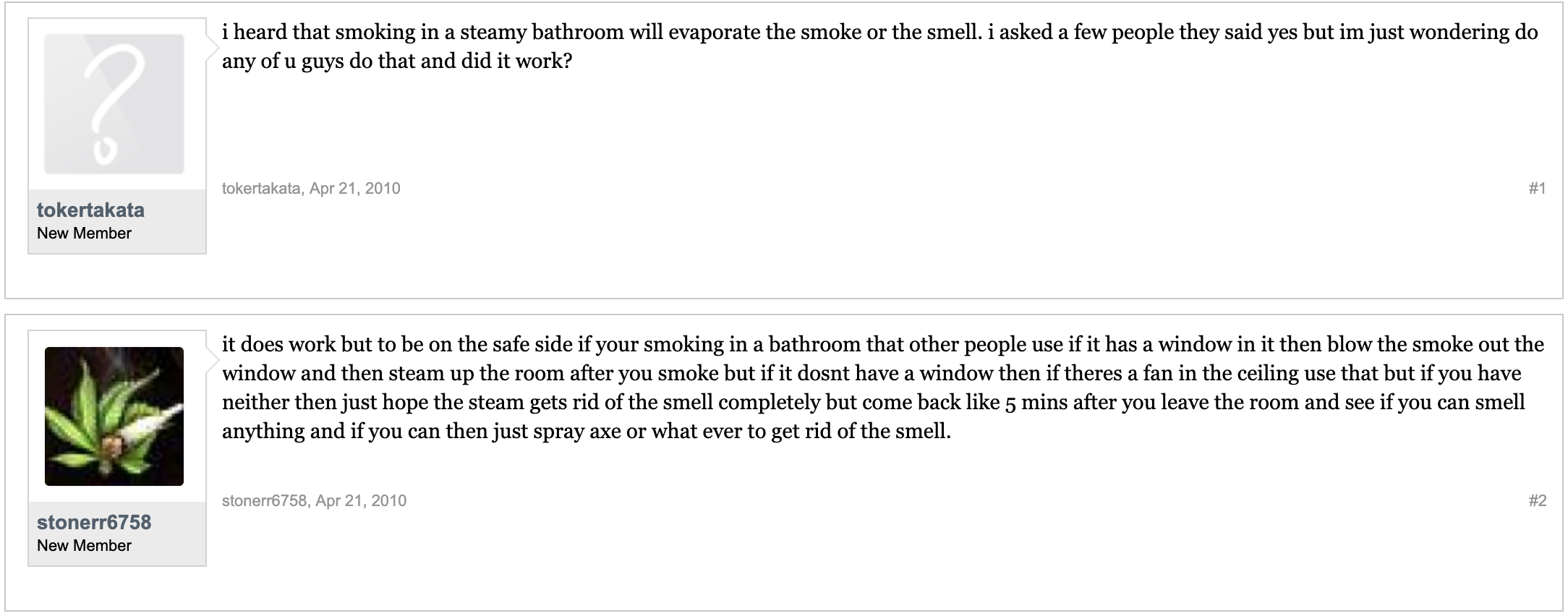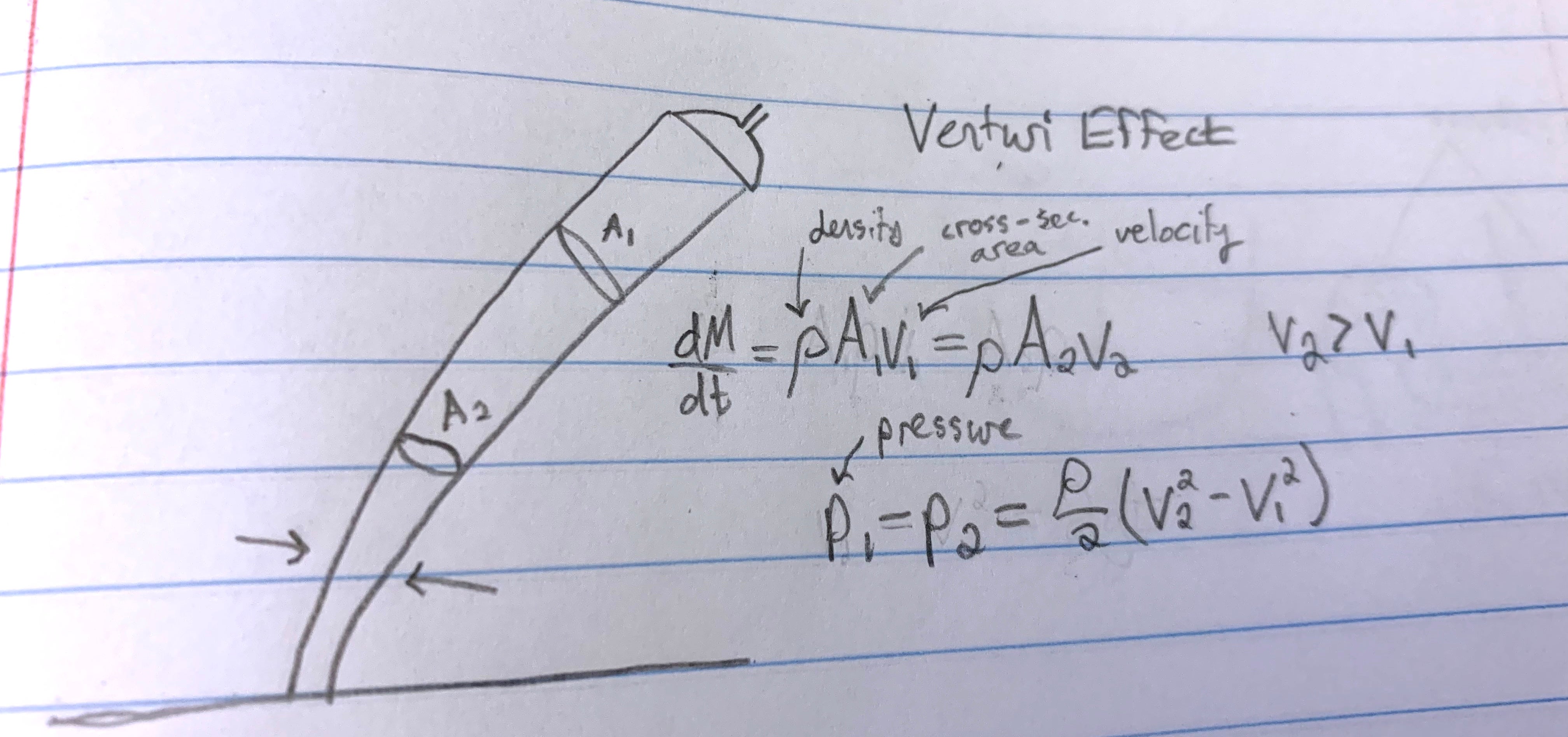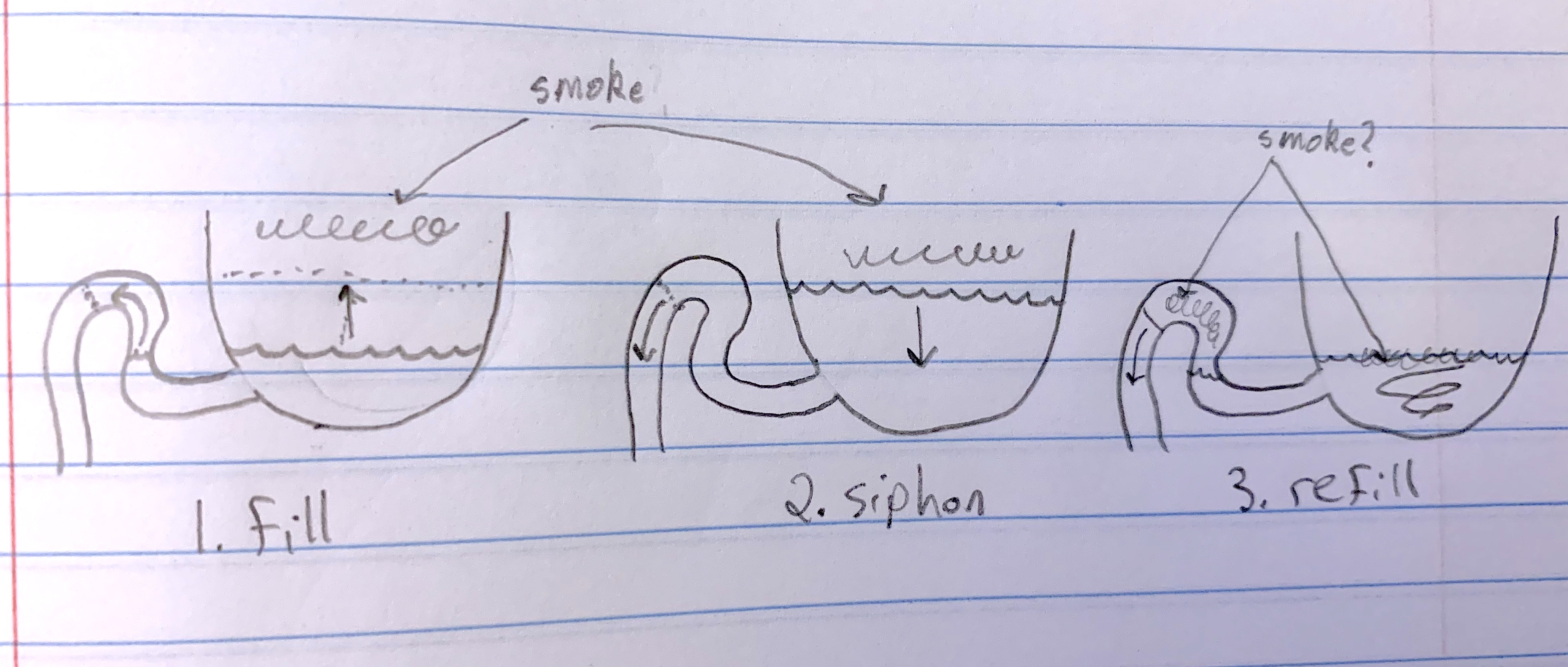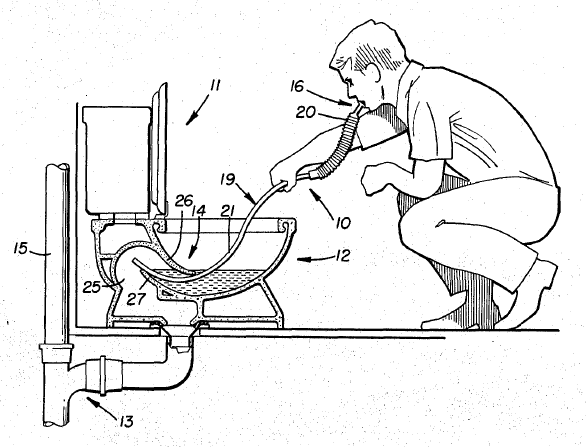Five of us crammed into a single-queen-bed hotel room after 22 straight hours on the road en route to the Sasquatch! music festival. You can probably connect the dots: College boys road-tripping across the country to a music fest were very much about to smoke a lot of weed, too.
But we were young, weed was still very illegal, and our first plan — attempting to smoke in the car and then enter the hotel — was derailed when a very nice family pulled into the parking spot next to us and whipped us into a paranoid frenzy.
So, we decided it had to happen in the hotel room. After some quick googling, we realized we weren’t the first stoners to try this. Enterprising stoners have been doing this for decades, and of course, there is some shaky stoner science to back it up. In fact, here is the exchange on the marijuana.com message boards we read at the time:

As the theory goes, if you smoke weed in a steamy room, the smell molecules of the weed will “stick” to the steam and dissipate.
Like old men in a YMCA sauna, we crammed into the steamy bathroom and passed around the bowl. We may have been extremely high, but in our minds, it worked! The perfect crime.
Or was it? We never stopped to wonder if we actually flooded our neighbors with steamy dankness without realizing it. So, feeling guilty, I asked a physicist to find out. And of course, using steam to mask weed smoke is a little more complicated than “sticky” molecules. Hey, it sounded smart at the time.
Smoking in a Hotel Room: Steam and Smoke Basics
In the stoner world, it’s common knowledge that to proficiently mask the smell of weed you should at the very least steam up your bathroom.
But why? Theories range from the idea that the steamed air is heavier, and pushes the smoke away, while others argue it’s some chemical reaction between the smoke and vapor particles. Turns out, it’s a bit of both.
The physicist, who asked to go by the pseudonym “Mark,” explains that at a very basic level, you’re trying to “minimize the smoke diffusion as much as possible.” In other words, you’re trying to keep the weed smoke from doing what gasses do: fill the space they occupy.

“Typically, the hot smoke will rise above the colder, denser air while it diffuses and mixes until its concentration is uniform throughout the room,” Mark explains. “One might think that the smoke would diffuse more quickly with the higher temperature of a steamy room, but the diffusion would also be suppressed by the slightly higher pressure in a well-sealed bathroom.”
Thus, he says, the main effect of the humidity on the diffusion of the weed smoke would by “the absorption of the water vapor by the smoke particles.”
“Unlike a typical uniform gas, smoke is made up of thousands of different compounds. Because some of these compounds are water-soluble, smoke particles will absorb water and even coagulate into larger, heavier particles,” he says. Since the smoke particles are now larger and heavier, they are also slower.
@amandabynes didnt any1 ever teach u how 2 smoke weed in a hotel room? bathroom+hottest shower ever = steam 10 yrs doin that nevr got caught
— Pennywise the clown (@PennyWiseIT_) July 19, 2013
This reduces the number of particles, he continues, and “when you also consider that the lower pressure area inside the shower caused by the falling water will tend to draw in air and smoke towards the lower pressure, I think that the suppression of smoke diffusion with heavy steam caused by a shower is plausible.”

In simple terms, the steam slightly increases the pressure inside your sealed bathroom and a lower-pressure system forms around the water falling from the showerhead itself. Your now-heavier weed-smoke particles will effectively be pulled toward the lower pressure of the shower steam, instead of simply filling the bathroom, your hotel room, the hotel hallway and the room full of police next door.
if you smoke in a bathroom, then put the hot water on really hot & steam it out, will the bathroom still smell like weed afterwards? #HELP
— princess horizon (@horizon_miller) June 10, 2012
As the physicist explains it, “The principle is that the falling water is accelerated by gravity, but to maintain the flow rate at a faster speed, the cross-sectional area of the falling water decreases. … This coincides with a reduction in the pressure of the water to maintain energy conservation and is known as the Venturi effect.”
Uh… what? “Remember those faucet vacuum things in chemistry class? Same idea.

Smoking in a Hotel Room: What About Vape Smoke?
Mark says he’s not totally sure how exhaled vape smoke would differ from exhaled smoke from a bowl. But the difference “for what kind of smoke you’re dealing with probably has to do with how the tobacco or weed is heated,” he says.
“It seems like there are fewer, more chemically simple ingredients in vape juice… [so] the smoke from vaporizing the juice probably has fewer large particles that come from the combustion of hydrocarbons while burning tobacco or weed.”
That being said, he’s not sure they’d be much different after exhaling.
"it doesnt count as sinning if you smoke weed in the shower god thinks it just steam" – my new book "fun ways to trick god"
— Meat (@KingMeat_) December 13, 2012
Smoking in a Hotel Room: The Toilet Method
Some stoner engineers will argue you should blow the smoke into the toilet bowl and flush it down. The heavy steam air will push the weed-smoke down, and the toilet-vacuum will pull the smelly cheeba smoke down into the plumbing, never to be seen or smelled by the good Christian families across the hall.
The math on this is a little shaky, Mark says. “Fluid dynamics is difficult and counterintuitive and we’re dealing with the interface of smoke and water.”
“If you imagine the surface of the toilet water as a piston and the bathroom as closed container, moving the piston out of the container (down), there is only a drop in the air pressure in the container because if the change in volume of the container, but the same number of air (and smoke) molecules,” he explains.
“Because the bathroom is not a closed system, technically air would enter to replace that displaced volume, but as the water returns, the situation returns to its initial state except that the smoke has had time to diffuse.”

Basically, it doesn’t work. The smoke would diffuse into the space of the room too quickly, and the change in pressure after a single flush is negligible. You wouldn’t achieve the Venturi effect after a simple flush.
To really hammer the point home, for science, Mark continues. “Most toilets utilize a siphon to empty the water when the level rises quickly enough to create a seal in the top of the “U”-shaped tube. … The siphon process then carries the water down the pipe until air enters and the siphon is broken, which causes of the classic flush sound.”
The physicist adds that the cause of the siphoning is complicated. “It has to do with intermolecular forces in the water, and at this point, the rest of the water continues to fill the toilet as the conservation of angular momentum has forced the water into a vortex.”
So, can any of this remove or suppress any smoke? “I would say maybe,” he says.
“When the water level falls during the siphoning, the void is replaced by the surrounding air, and when the siphon is broken, some of that air could get caught in a bubble between the siphoned water and the replacement water. … But the answer probably lies in the specific variables and would require controlled experiments to determine. I feel like I would have to construct some major rigs on different toilets for experimentation, and even then answer could range from no effect (slow toilet) to ‘maybe’ some effect (blowing directly into a high-flow toilet). My problem is that range could be 0–0.1%.”
If there’s any hope to the flushing technique, it lies in the new-age high-pressure toilets.
This might “cause some suction from the Venturi effect caused by the quickly accelerating flushed water,” he says. “Another side effect of quick-flushing toilets is that their turbulent flush can cause liquid-gas mixing from which some molecules will be dissolved and larger particles will settle.”

Through trial and error, it seems some stoners have come to the conclusion that simply blowing smoke into a flushing toilet doesn’t work. Some recommend getting a three-foot tube to siphon the cloud into the bend of the toilet’s pipes.
How to smoke in any bathroom *****GUARANTEED***** from Drugs
“That looks promising,” the physicist laughs. “There’s historical precedent for that too! During a rash of hotel fires in the 1980s, a guy named William H. Holmes invented a toilet snorkel, which allowed you to breathe clean air in case of a fire. So yeah, if you have a tube handy, that would probably work.”

Smoking in a Hotel Room: The Wet Towel Under the Door
With the flush theory debunked, we return to the steamy bathroom. Remember that you want to keep the smoke contained to a small area, and in order to do that, you need to seal the crack at the bottom of the door. And according to stoner engineers, the best way to do that is by sealing the bathroom door with a wet towel.
But why a wet towel? “It might have something to do with surface tension of water, the polar nature of the water molecule, or the fact that a wet towel is more dense and thus is less porous to air flow through it,” Mark explains. “Water has adhesive properties but mostly just increases the density and makes the dry towel filtering more effective.” Overall, he says it “definitely works to a degree, dry or wet.”
Smoking in a Hotel Room: Blowing Into the Fan
Many hotel-smokers will have you believe blowing directly into the bathroom’s exhaust fan is your best bet. But that’s actually not the case. For one, many hotel bathrooms don’t even have exhaust fans, and if they do, you don’t really know where that exhaust is going. It could be going nowhere.
ELI5: Why don’t hotels put exhaust fans in their bathrooms? from explainlikeimfive
Plus, Mark says, if you’ve steamed up the bathroom, your best smoke-masking effects will only happen if you’re as close to the low-pressure systems as possible.
“Any absorbing or low-pressure suction effects would be stronger closer to the water. So any toilets effects would be stronger with smoke in the toilet, and shower effects would be stronger in the shower,” he says.
wow i just love wasting water to steam up the bathroom so it doesn’t smell like weed after a smoke sesh
— nervous passenger (@brckhnnh) November 28, 2017
Overall, he concludes, “The most promising way to suppress the smoke in a bathroom with no other options would be to use the shower to saturate the room with steam and to exhale into the shower with a closed curtain.
“Any pressure difference and the curtain will localize the smoke in the shower and the falling water and steam will slow down and break up the smoke into nothing.”
And, if you’re really looking to break up the smoke and have the supplies, whip up a quick “doob tube.”
That is, “a paper towel roll filled with dryer sheets or more towels. … It’s essentially what a filter in a cig does: You can see the brown carbon and tar on the towel.”

